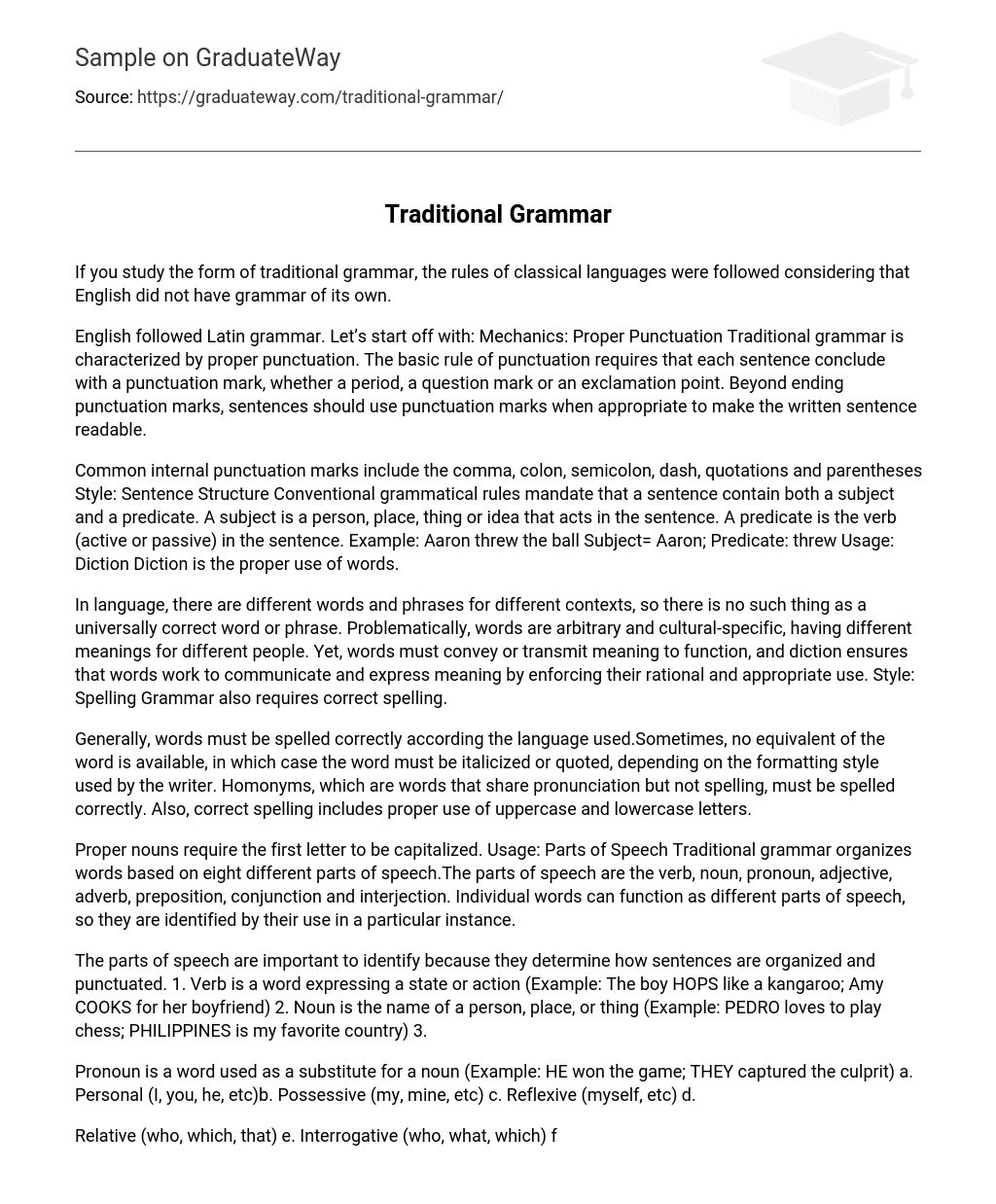If you study the form of traditional grammar, the rules of classical languages were followed considering that English did not have grammar of its own.
English followed Latin grammar. Let’s start off with: Mechanics: Proper Punctuation Traditional grammar is characterized by proper punctuation. The basic rule of punctuation requires that each sentence conclude with a punctuation mark, whether a period, a question mark or an exclamation point. Beyond ending punctuation marks, sentences should use punctuation marks when appropriate to make the written sentence readable.
Common internal punctuation marks include the comma, colon, semicolon, dash, quotations and parentheses Style: Sentence Structure Conventional grammatical rules mandate that a sentence contain both a subject and a predicate. A subject is a person, place, thing or idea that acts in the sentence. A predicate is the verb (active or passive) in the sentence. Example: Aaron threw the ball Subject= Aaron; Predicate: threw Usage: Diction Diction is the proper use of words.
In language, there are different words and phrases for different contexts, so there is no such thing as a universally correct word or phrase. Problematically, words are arbitrary and cultural-specific, having different meanings for different people. Yet, words must convey or transmit meaning to function, and diction ensures that words work to communicate and express meaning by enforcing their rational and appropriate use. Style: Spelling Grammar also requires correct spelling.
Generally, words must be spelled correctly according the language used.Sometimes, no equivalent of the word is available, in which case the word must be italicized or quoted, depending on the formatting style used by the writer. Homonyms, which are words that share pronunciation but not spelling, must be spelled correctly. Also, correct spelling includes proper use of uppercase and lowercase letters.
Proper nouns require the first letter to be capitalized. Usage: Parts of Speech Traditional grammar organizes words based on eight different parts of speech.The parts of speech are the verb, noun, pronoun, adjective, adverb, preposition, conjunction and interjection. Individual words can function as different parts of speech, so they are identified by their use in a particular instance.
The parts of speech are important to identify because they determine how sentences are organized and punctuated. 1. Verb is a word expressing a state or action (Example: The boy HOPS like a kangaroo; Amy COOKS for her boyfriend) 2. Noun is the name of a person, place, or thing (Example: PEDRO loves to play chess; PHILIPPINES is my favorite country) 3.
Pronoun is a word used as a substitute for a noun (Example: HE won the game; THEY captured the culprit) a. Personal (I, you, he, etc)b. Possessive (my, mine, etc) c. Reflexive (myself, etc) d.
Relative (who, which, that) e. Interrogative (who, what, which) f. Demonstrative (this ,that) 4. Adjective is a word describing (or ‘qualifying’) a noun (Example: The Earth is an OBLATE SPHEROID; Susie is INTELLIGENT) 5.
Adverb is a word that qualifies a verb or an adjective (Example: The man ran QUICKLY; Anne is REALLY beautiful) 6. Prepositions are used to relate nouns or pronouns grammatically to the rest of the sentence. They can be either simple (Example: at, on, by, through, with) or compound (Example: away from, because of, by means of). 7.
Conjunctions are used to link words or groups of words. Conjunctions can be coordinating (Example: and, but, or) or subordinating (Example: if, although, because, that, when, so that); Like prepositions, they can be either simple (Example: and, but, if) or compound (Example: so that, provided that, as long as).





